Sarah Bernhardt
| Sarah Bernhardt | |
|---|---|
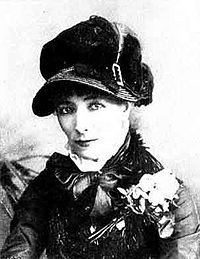 Bernhardt in June 1877, during a visit to Boston, Massachusetts |
|
| Born | Sara-Marie-Henriette Rosine Bernard ca. October 23, 1844[1] Paris, France |
| Died | March 26, 1923 (aged 78) Paris, France |
| Years active | 1862–1923 |
| Spouse | Ambroise Aristide Damala (m. 1882–1889) |
Sarah Bernhardt (born circa October 23, 1844 – March 26, 1923) was a French stage and early film actress, and has been referred to as "the most famous actress the world has ever known".[2] Bernhardt made her fame on the stages of Europe in the 1870s, and was soon in demand in Europe and the Americas. She developed a reputation as a serious dramatic actress, earning the nickname "The Divine Sarah".
Contents |
Early life
Bernhardt was born in Paris as Rosine Bernardt,[3] the illegitimate daughter of Julie Bernardt (1821, Amsterdam – 1876, Paris) and an unknown father. Julie was one of six children of a widely traveling Jewish spectacle merchant, "vision specialist" and petty criminal, Moritz Baruch Bernardt, and Sara Hirsch (later known as Janetta Hartog) (ca 1797–1829).[4] Julie's father remarried Sara Kinsbergen (1809–1878) two weeks after his first wife's death, and abandoned his family in 1835.[4] Julie left for Paris, where she made a living as a courtesan and was known by the name "Youle". Sarah would add the letter "H" to both her first and last name. Sarah's birth records were lost in a fire in 1871, but in order to prove French citizenship, necessary for Légion d'honneur eligibility, she created false birth records, on which she was the daughter of "Judith van Hard" and "Edouard Bernardt" from Le Havre, in later stories either a law student, accountant, naval cadet or naval officer.[4][5]
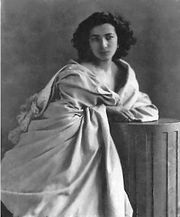
As the presence of a baby interfered with her mother's terrible and stressful life, Sarah was brought up in a pension, and later in a convent. A child of delicate health, she considered becoming a nun, but one of her mother's reputed lovers, the future Duc de Morny, Napoleon III's half-brother, decided that she should be an actress. When she was 13, he arranged for her to enter the Conservatoire, the government sponsored school of acting. She was not considered a particularly promising student, and, although she revered some of her teachers, she regarded the Conservatoire's methods as antiquated and too deeply steeped in tradition.[6][7]
Much of the uncertainty about Bernhardt's life arises because of her tendency to exaggerate and distort. Alexandre Dumas, fils described her as a notorious liar.[2]
Stage career
Sarah Bernhardt left the Conservatoire in 1862, and, thanks to the Duc de Morny‘s influence, was accepted by the national theatre company, the Comédie-Française, as a beginner on probation. During the obligatory three debuts required of probationers, the strength, beauty, and sheer virtuosity of her performance was scarcely noticed by critics. Her contract with Comédie-Française was cancelled in 1863 after she slapped the face of a senior actress who had been rude to her younger sister. For a time she found employment at the Théâtre du Gymnase-Dramatique where she was given the part of a silly, Russian princess which further compromised her already volatile reputation. She decided to leave France and travel Europe. She soon ended up in Belgium, where she became the mistress of Henri, Prince de Ligne, and gave birth to their son, Maurice in 1864. After Maurice's birth, the Prince proposed marriage, but his family forbade it and convinced Bernhardt to refuse and end their relationship.[8]
In 1866 she signed a contract with Odéon theatre and during six years of intensive work with a congenial company there, gradually established her reputation. Her first resounding success was as Anna Damby in the 1868 revival of Kean (by the novelist and playwright Alexandre Dumas père). Bernhardt’s greatest triumph at the Odéon, however came 1869 when she portrayed the minstrel Zanetto in the one-act verse play Le Passant (“The Passerby”) by the young dramatist François Coppée – a part of which she played again in a command performance before Napoleon III.[9][10]
It was during this time that she acquired her famous coffin, in which she often slept in lieu of a bed, claiming it helped her understand her many tragic roles. She made her fame on the stages of Europe in the 1870s, and was soon in demand all over Europe and in New York.[11] She developed a reputation as a serious dramatic actress, earning the title "The Divine Sarah"; arguably, she was the most famous actress of the 19th century.[12]
During the Franco-Prussian War in 1870, she organized a military hospital in the Odéon. After the war, the reopened Odéon paid tribute to the 19th century writer Victor Hugo with a production of his verse-play Ruy Blas. As Queen Maria, Bernhardt charmed her audiences with lyrical quality of her voice. It was then that Hugo coined the phrase “golden voice,” though her critics usually called her voice “silvery” – as resembling the tone of a flute.[13]
In 1872 she left the Odéon and returned to Comédie-Française. One of her remarkable success there was in the title role of Voltaire's Zaïre (1874). She even traveled to Cuba and performed in the Sauto Theater, in Matanzas, in 1887. She coached many young women in the art of acting, including actress and courtesan Liane de Pougy.
Personal life
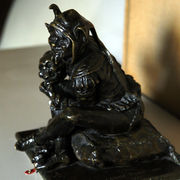
Bernhardt had an affair with a Belgian nobleman, Charles-Joseph Eugène Henri Georges Lamoral de Ligne (1837–1914), son of Eugène, 8th Prince of Ligne, with whom she had her only child, Maurice Bernhardt, in 1864. He married a Polish princess, Maria Jablonowska (see Jablonowski).
Sarah's close friends would include several artists, most notably Gustave Doré and Georges Clarin, and actors Mounet-Sully and Lou Tellegen, as well as the famous French author Victor Hugo. Alphonse Mucha based several of his iconic Art Nouveau works on her. Her friendship with Louise Abbéma (1853–1927), a French impressionist painter, some nine years her junior, was so close and passionate that the two women were rumored to be lovers. In 1990, a painting by Abbéma, depicting the two on a boat ride on the lake in the bois de Boulogne, was donated to the Comédie-Française. The accompanying letter stated that the painting was "Peint par Louise Abbéma, le jour anniversaire de leur liaison amoureuse."[14]

She later married Greek-born actor Aristides Damala (known in France by the stage name Jacques Damala) in London in 1882, but the marriage, which legally endured until Damala's death in 1889 at age 34, quickly collapsed, largely due to Damala's dependence on morphine. During the later years of this marriage, Bernhardt was said to have been involved in an affair with the Prince of Wales, who later became Edward VII.[15]
Bernhardt once stated, "Me pray? Never! I'm an atheist."[16] However, she had been baptised a Roman Catholic, and accepted the last rites shortly before her death.[17]
Silent film career
Bernhardt was one of the pioneer silent movie actresses, debuting as Hamlet in the two minute long film Le Duel d'Hamlet in 1900. (Technically, this was not a silent film, as it had an accompanying Edison cylinder with sound effects.)[18] She went on to star in eight motion pictures and two biographical films in all. The latter included Sarah Bernhardt à Belle-Isle (1912), a film about her daily life at home.
Later career

In 1905, while performing in Victorien Sardou's La Tosca in Rio de Janeiro, Bernhardt injured her right knee when jumping off the parapet in the final scene. The leg never healed properly. By 1915, gangrene had set in and her entire right leg was amputated, confining her to a wheelchair for several months. Bernhardt reportedly refused a $10,000 offer by a showman to display her amputated leg as a medical curiosity (while P.T. Barnum is usually cited as the one to have made the offer, he had been dead since 1891). She continued her career without using a wooden prosthetic limb; she had tried to use one but didn't like it). She carried out a successful tour of America in 1915, and on returning to France she played in her own productions almost continuously until her death. Her later successes included Daniel (1920), La Gloire (1921), and Régine Armand (1922). Her physical condition confined her practically to immobility on the stage, but the charm of her voice, which had altered little with age, ensured her triumphs.[19]
Bernhardt has a star on the Hollywood Walk of Fame at 1751 Vine Street.
Books
- Dans les nuages, Impressions d'une chaise (1878)
- L'Aveu, drame en un acte en prose (1888)
- Adrienne Lecouvreur, drame en six actes (1907)
- Ma Double Vie (1907), & as My Double Life: Memoirs of Sarah Bernhardt, (1907) William Heinemann
- Un Coeur d'Homme, pièce en quatre actes (1911)
- Petite Idole (1920; as The Idol of Paris, 1921)
- L'Art du Théâtre: la voix, le geste, la prononciation, etc. (1923; as The Art of the Theatre, 1924)
Selected roles
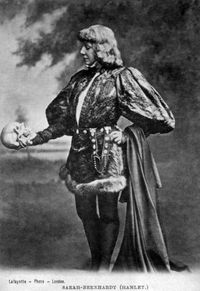

- 1862: Racine's Iphigénie in the title role, her debut.
- 1862: Eugène Scribe's Valérie
- 1862: Molière's Les Femmes Savantes
- 1864: Labiche & Deslandes, Un Mari qui Lance sa Femme
- 1866: T & H Cognard's La Biche aux Bois
- 1866: Racine's Phèdre (as Aricie)
- 1866: Pierre de Marivaux's Le Jeu de l'Amour et du Hasard (as Silvia)
- 1867: Molière's Les Femmes Savantes (as Armande)
- 1867: George Sand's Le Marquis de Villemer
- 1867: Georges Sand's "François le Champi" (as Mariette)
- 1868: Dumas père's Kean (as Anna Damby)
- 1869: Coppée's La Passant, as a male troubadour (Zanetto); her first major stage success
- 1870: George Sand's L'Autre
- 1871: Theuriet's Jeanne-Marie
- 1871: Coppée's Fais ce que Dois
- 1871: Foussier and Edmond La Baronne
- 1872: Bouilhet's Mademoiselle Aïssé
- 1872: Hugo's Ruy Blas (as Doña Maria de Neubourg, Queen of Spain)
- 1872: Dumas père Mademoiselle de Belle-Isle (as Gabrielle)
- 1872: Racine's Britannicus (as Junie)
- 1872: Beaumarchais's Le Mariage de Figaro
- 1872: Sandeau's Mademoiselle de la Seiglière
- 1873: Feuillet's Dalila (as Princess Falconieri)
- 1873: Ferrier's Chez l'Avocat
- 1873: Racine's Andromaque
- 1873: Racine's Phèdre (as Aricie)
- 1873: Feuillet's Le Sphinx''
- 1874: Voltaire's Zaire
- 1874: Racine's Phèdre (as Phèdre)
- 1875: Bornier's La Fille de Roland
- Dumas fils' L'Étrangère (as Mrs. Clarkson)
- Parodi's Rome Vaincue
- 1877: Hugo's Hernani (as Doña Sol)
- 1879: Racine's Phèdre (as Phèdre)
- 1880: Émile Augier's L'Aventurière
- 1880: Legouvé & Scribe's Adrienne Lecouvreur
- 1880: Meilhac & Halévy's Froufrou
- 1880: Dumas fils' La Dame aux Camélias (as Maguerite)
- 1882: Sardou's Fédora''
- Sardou's Théodora (as Theodora, Empress of Byzantium)
- 1887 : Victorien Sardou's La Tosca
- Dumas fils' La Princesse Georges
- 1890: Sardou's Cléopâtre, as Cleopatra
- 1893: Lemaître's Les Rois
- 1894: Sardou's Gismonda
- 1895: Molière's Amphytrion
- 1895: Magda(translation of Sudermann's Heimat)
- 1896: La Dame aux Camélias
- 1896: Musset's Lorenzaccio (as Lorenzino de' Medici)
- 1897: Sardou's Spiritisme
- 1897: Rostand's La Samaritaine
- 1897: Octave Mirbeau's Les Mauvais bergers
- 1898: Catulle Mendès Medée
- 1898: La Dame aux Camélias (as Marguerite Gautier)
- Barbier's Jeanne d'Arc (as Joan of Arc)
- Morand & Sylvestre's Izéïl (as Izéïl)
- Shakespeare's King Lear (as Cordelia)
- 1899: Shakespeare's Hamlet (as Hamlet)
- Shakespeare's Antony and Cleopatra (as Cleopatra)
- Shakespeare's Macbeth (as Lady Macbeth) (in French)
- Richepin's Pierrot Assassin (as Pierrot)
- 1900: Rostand's L'Aiglon as L'Aiglon
- 1903: Sardou's La Sorcière
- 1904: Maeterlinck's Pelléas et Mélisande (as Pelléas)
- 1906: Ibsen's The Lady From the Sea
- 1906: Mendès' La Vierge d'Avila (as Saint Theresa)
- 1911: Moreau's Queen Elizabeth (as Queen Elizabeth)
- 1913: Bernard's Jeanne Doré (as Jeanne Doré)
Filmography
,_Sarah-Benhardt.jpg)
- 1900: Le Duel d'Hamlet (Hamlet, as Hamlet) An excerpt from the play, featuring Bernhardt in a duel to the death with Laertes.
- 1908: La Tosca (Tosca, as Tosca) A one-reel condensation of the play by the same name by Victorien Sardou.
- 1911: La Dame aux Camélias (Lady of the Camelias – Camille, in the U.S. release, as Camille) A two-reel condensation of the play by the same name, and co-starring Lou Tellegen.
- 1912: Adrienne Lecouvreur (An Actress's Romance; as Adrienne Lecouvreur) A two-reel condensation of the play by the same name. Co-starring Lou Tellegen.
- 1912: Les Amours d'Elisabeth, Reine d'Angleterre (Queen Elizabeth; a major success) A four-reel condensation of the play of the same name. Co-starring Lou Tellegen.
- 1912: Sarah Bernhardt à Belle-Isle (Sarah Bernhardt at Home, as herself) This documentary features Sarah at home with her family and friends, fishing for shrimp, and cuddling indoors with her pet dogs.
- 1915: Mères Françaises (Mothers of France, as Madame Jeanne D'Urbex, a war widow in World War I. When she learns that her son has also been wounded, she searches the battlefields, crawls through trenches, and finally reaches him at a medical station only to have him die in her arms. After this tragedy, she dedicates her life to helping others survive the ravages of war.
- 1915: Ceux de Chez Nous (Those at Home: biographical, home movies) Among other celebrated persons of the era, there is a brief scene featuring Sarah sitting on a park bench and reading from a book.
- 1916: Jeanne Doré (as Jeanne Doré). Based on a play of the same name. Sarah appears as a widowed mother, who lavishes attention on her son, Jacques. When he is seduced by a temptress and accidentally murders a man, she visits him in his cell on the night before his execution, pretending to be his fiancée.
- 1921: Daniel (5-minute death scene from the play of the same name.) Sarah appears as a morphine addict in the hour before death.
- 1923: La Voyante (The Fortune Teller,) Sarah appears as a clairvoyant, who makes predictions that influence the outcome of national events. This film was Sarah's final performance, and was made while she was mortally ill. It was eventually completed with scenes made with a stand-in performing Bernhardt's character with her back turned to the camera.
Recordings
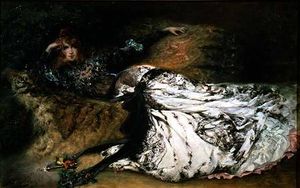
Georges Clairin (1843–1919) oil painting on canvas
- Phèdre (1902)
- Le Lac (The Lake) (1902)
- La Fiancée du Timbalier (1902)
- Lucie (1902)
- Le Lac (1903)
- La Samaritaine (1903)
- Les Vieux (The Old Ones) (1903)
- Un Évangile (A Gospel) (1903)
- Phèdre (1903)
- La Mort d'Izéil (The Death of Izéil) (1903)
- La Rêverie de Théroigne de Méricourt (The Dream of Théroigne de Méricourt) (1903)
- Un Peu de Musique (A Little Music) (1903)
- L'Aiglon (The Eaglet) (1910)
- Phèdre (1910)
- Les Buffons (The Buffoons) (1908)
- La Samaritaine (1910)
- L'Étoile dans la Nuit (The Star in the Night) (1918)
- Prière pour nos Ennemis (A Prayer for our Enemies) (1918)
References
- ↑ She was baptised in 1857, when she was about 12, but the record is missing. A birth date taken from a certificate of a baptism conducted at the age of 12 would not be reliable as a primary source, and could only be used to corroborate other evidence. (In The Art of High Drama, a Professor Ockman describes finding an "unidentified newspaper clipping" in the Bibliothèque de la Comédie Francaise in Paris, which included a copy of a baptismal certificate saying Bernhardt was born on 25 September 1844.) It has been claimed that "Bernhardt sometimes celebrated her birthday on 23 October", although there is no verification of this claim. Bernhardt’s 1907 autobiography Ma double vie (My Double Life) made no reference to her date of birth.
- ↑ 2.0 2.1 Gottlieb, Robert. "The Drama of Sarah Bernhardt". http://www.nybooks.com/articles/20151. Retrieved 2007-10-18.
- ↑ In 1859 she enrolled with that name and a birthdate of 28 October 1844 at the Conservatoire National; this is the only record surviving from before her birth record was lost in 1871. See "Snel, Harmen. The ancestry of Sarah Bernhardt; a myth unravelled, Amsterdam, Joods Historisch Museum, 2007, ISBN 978-90-8020-293-1, pp 9–10". Snel argues that since her birth record was still available and there was little reason to obscure the truth, "this registration can be regarded as founded on facts".
- ↑ 4.0 4.1 4.2 Snel, Harmen. "The ancestry of Sarah Bernhardt; a myth unravelled", Amsterdam, Joods Historisch Museum, 2007, ISBN 978-90-8020-293-1
- ↑ Sarah's fictitious father was named after her uncle Eduard Bernardt, youngest (half) brother (born ca 1826) of her mother, who was raised in a boarding school in Tours and emigrated to Chile before 1860 (see Snel, p. 82)
- ↑ Colombier Marie. "Le voyage de Sarah Bernhardt en Amérique"
- ↑ Sarah Bernhardt (1933), a biography based on Bernhardt's memoirs
- ↑ Madame Sarah, Cornelia Otis Skinner, Houghton Mifflin 1966
- ↑ May Agate, Madame Sarah (1945)
- ↑ Encyclopedia Britannica – Macropædia (Knowledge in Depth) Volume 2
- ↑ Sarah Bernhardt at the Internet Broadway Database
- ↑ Golden, Eve. "From Stage to Screen: The Film Career of Sarah Bernhardt". http://www.classicimages.com/past_issues/view/?x=/1997/june/bernhard.html. Retrieved 2007-10-18.
- ↑ C. O. Skinner, Madame Sarah (1967), and excellent book primarily biographical attempt at separating fact from fiction
- ↑ Guibert et. al., Portrait(s) de Sarah Bernhardt, 2000
- ↑ "Edward VII biography". http://www.geocities.com/jesusib/EdwardVII.html. Retrieved 2007-10-18.
- ↑ "Positive Atheism's Big List of Quotations: Sarah Bernhardt". http://www.positiveatheism.org/hist/quotes/quote-b0.htm. Retrieved 2007-10-18.
- ↑ .Sarah Bernhardt in the Theatre of Films and Sound Recordings, by David W. Menefee, McFarland & Company, Inc, 2003
- ↑ "Filming Shakespeare With And Without Words In Settings Familiar And Unfamiliar". http://www.isntlifeterrible.com/labels/film%20preservation.html. Retrieved 2007-10-18.
- ↑ "New International Encyclopedia". http://en.wikipedia.org/wiki/New_International_Encyclopedia. Retrieved 2007-10-18.
Further reading
- Brandon, Ruth. Being Divine: A Biography of Sarah Bernhardt. London: Mandarin, 1992.
- Gold, Arthur and Robert Fitzdale. The Divine Sarah: A Life of Sarah Bernhardt. New York: Alfred A. Knopf, 1991.
- Lorcey, Jacques. Sarah Bernhardt, l'art et la vie, Paris : Éditions Séguier, 2005. 160 pages. Avec une préface d'Alain Feydeau. ISBN 2-84049-417-5.
- Menefee, David W. Sarah Bernhardt in the Theater of Films and Sound Recordings. North Carolina: McFarland, 2003.
- Menefee, David W. The First Female Stars: Women of the Silent Era. Connecticut: Praeger, 2004.
- Ockmann, Carol and Kenneth E. Silver. Sarah Bernhardt: The Art of High Drama New York: Yale University Press, 2005
- Skinner, Cornelia Otis. Madame Sarah. Paragon House, 1966.
- Snel, Harmen. "The ancestry of Sarah Bernhardt; a myth unravelled", Amsterdam, Joods Historisch Museum, 2007, ISBN 978-90-8020-293-1
External links
- The Sarah Bernhardt Pages
- Sarah Bernhardt at Find a Grave
- Works by Sarah Bernhardt at Project Gutenberg
- Sarah Bernhardt at the Internet Broadway Database
- Performances in Theatre Archive University of Bristol
- Sarah Bernhardt at the Internet Movie Database
- Sarah Bernhardt at Allmusic
- Sarah Bernhardt cylinder recordings, from the Cylinder Preservation and Digitization Project at the University of California, Santa Barbara Library.
- Sarah Bernhardt Collection at the Harry Ransom Center at the University of Texas at Austin.
- Bernhardt's sculpture
- Bibliography
- Sarah Bernhardt photo gallery series 1 NYP Library
- Sarah Bernhardt photo gallery series 2 NYP Library
- Bernhardt appears in Venice, California, 1906